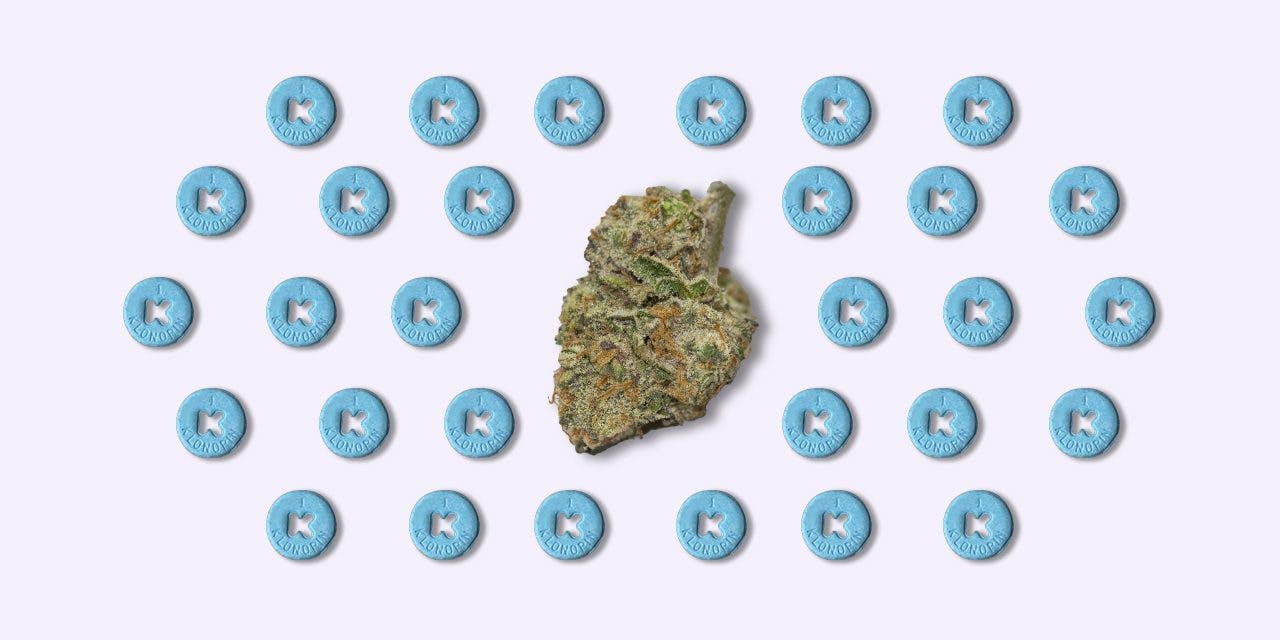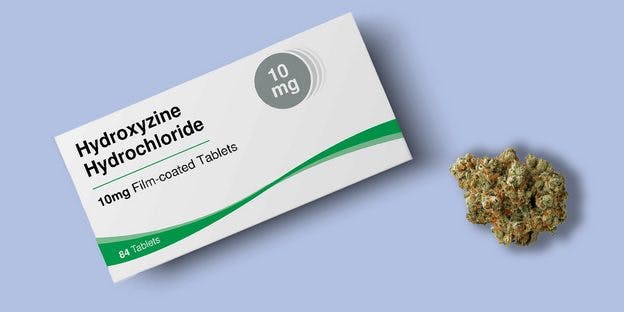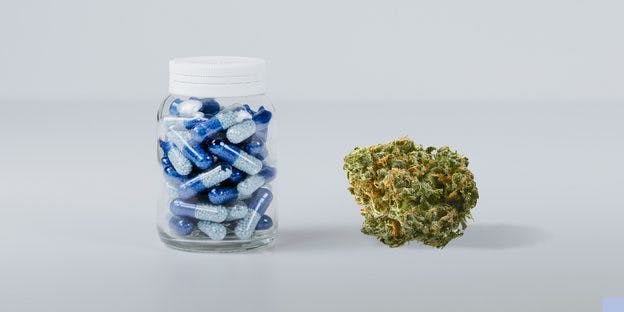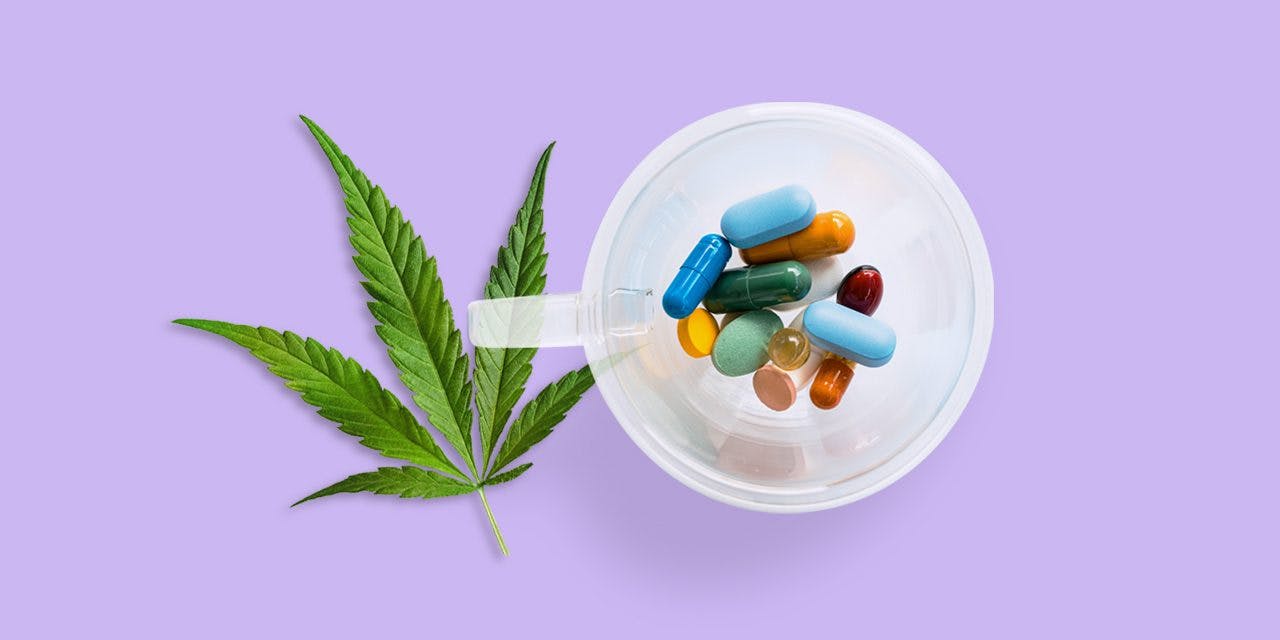Can You Use Marijuana If You Take Klonopin?

Article written by

Dipak HemrajHead of Research and Education
Content reviewed by

Dr. Lewis JasseyMedical Director - Pediatric Medicine
Klonopin (clonazepam) is a sedative benzodiazepine with a moderate drug-drug interaction with cannabis (marijuana). Cannabinoids in cannabis, like tetrahydrocannabinol (THC) and cannabidiol (CBD), can desensitize liver enzymes of the cytochrome P450 (CYP450) family and prohibit the metabolization of Klonopin and other benzodiazepines. This means that cannabis can increase the level of Klonopin in the body, potentially increasing the chances of adverse side effects.
Get your medical marijuana card
Connect with a licensed physician online in minutes.
What Is Klonopin?
Klonopin is the trade name for clonazepam, a tranquilizer of the benzodiazepine class of prescription medications. Other brand names for clonazepam include Rivotril, Clonapax and Klopam.
Uses and How It Works
Klonopin is prescribed for the prevention and treatment of seizures, anxiety, panic disorders, muscle disorders like restless leg syndrome (RLS) and spasticity associated with Lou Gehrig’s disease, alcohol withdrawal symptoms, and the movement disorder akathisia (constant fidgeting, restlessness, and an inability to sit still caused by mental distress).
Clonazepam binds to GABAA receptors, thus increasing the effect of the chief inhibitory neurotransmitter γ-aminobutyric acid (GABA). This gives clonazepam its anti-convulsant, anxiolytic (anti-anxiety), and skeletal relaxant properties.
Although clonazepam is effective for conditions such as epilepsy and some anxiety disorders, it does have several negative side effects. These include sleepiness, agitation, poor coordination, addiction, and an increased risk of suicide. It can also be addictive: Dependence occurs in one-third of people who take clonazepam for longer than four weeks.
Potential Benefits and Risks of Mixing Cannabis and Klonopin
There are both positives and negatives when combining cannabis use with Klonopin, especially as both medications have sedative effects, and cannabinoids can interfere with metabolizing some other drugs.
Potential Benefits
- Medical marijuana could help lower the dose of Klonopin/clonazepam needed or potentially even replace it entirely, helping reduce dependence (benzodiazepine use disorder).
- Cannabinoids like CBD have effectively reduced and prevented seizures associated with epilepsy. CBD could help reduce reliance on Klonopin and other benzodiazepines, with the added advantage of being more tolerable by the human body and having a far better safety profile.
- Cannabis contains several sedative and stress-busting terpenes and cannabinoids that can help alleviate stress, inflammation, and anxiety, such as cannabinol (CBN), cannabichromene (CBC), linalool, myrcene, and limonene.
- Cannabis withdrawal has no reported fatal consequences, whereas benzodiazepine withdrawal is dangerous.
Download Free Guide to CBN
Download Free Guide to CBC
Potential Risks
- Cannabinoids like CBD interfere with the metabolization of benzodiazepines like Klonopin, increasing the level of benzodiazepines in the body and increasing the likelihood of suffering an adverse side effect.
- Cannabis can increase the sedative effects of benzodiazepines.
What to Do If You Need to Use Both Klonopin and Marijuana
As there can be potentially severe reactions if combining Klonopin with marijuana use, it is wise to consult a physician if you are going to use the two together. You may need to taper your use of Klonopin if you are using cannabis, and sudden withdrawal of benzodiazepine is not safe.
The Bottom Line
It is not ideal to use cannabis and Klonopin together, as there are drug interactions between the two. However, some people may still use the two together when dosed appropriately under medical supervision. It is wise to speak to a doctor if you intend to utilize medical cannabis for a medical condition and reduce your use of Klonopin or any other benzodiazepine, as withdrawal can be high-risk, painful, and dangerous.
Frequently Asked Questions
What can you not take with clonazepam?
Klonopin (clonazepam) has 28 major, 429 moderate, and 31 minor interactions with other drugs. Most major interactions are with opioid-based painkillers, where concurrent use of benzodiazepines can cause extreme and deadly sedation of the central nervous system (CNS), including slowed and stopped breathing. Using opioids and benzodiazepines together has several potential negative consequences.
Most moderate interactions are with other drugs with sedative properties, including other benzodiazepines, alcohol, antidepressants, antihistamines, and some types of migraine prescription drugs. Cannabis also has a moderate drug-drug interaction with clonazepam.
How long does Klonopin stay in your system?
Klonopin’s effects can last up to 12 hours, and Klonopin’s effects tend to last longer than most other benzodiazepines.
Can you mix Klonopin and Xanax?
Klonopin and Xanax (alprazolam) have a moderate drug-drug interaction. Using the two together can increase side effects such as dizziness, drowsiness, confusion, and difficulty thinking.



